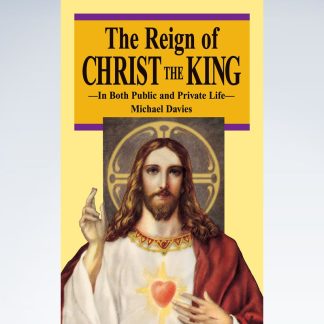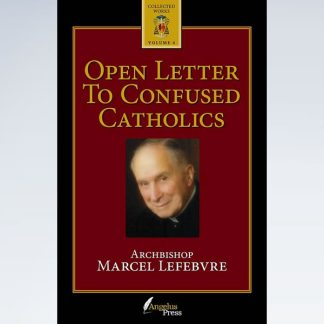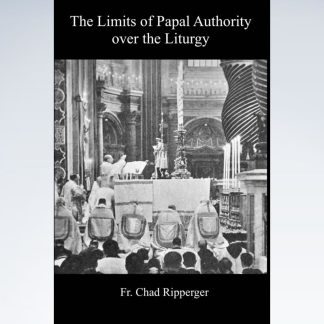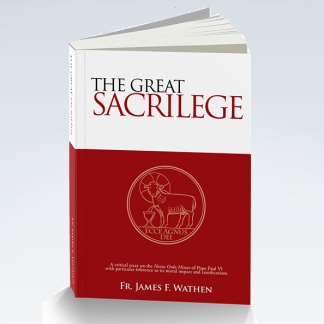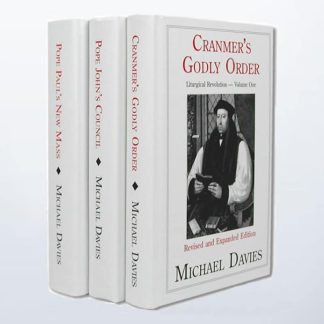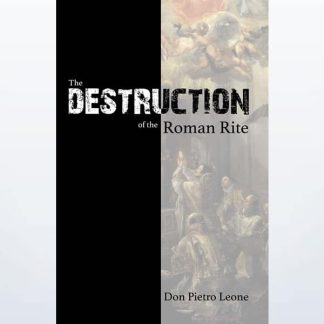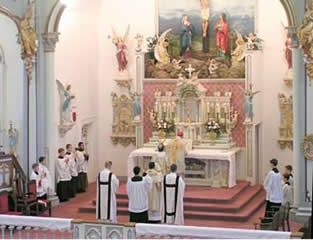
Michael Davies is most known for his work on the liturgical revolution. He summarizes how the movement for liturgical reform transmuted into the monster that it became, and then used Vatican II, the organs established to effect the reforms of Vatican II, and the “spirit of the Council” to create the new liturgy.
During the first session of the Second Vatican Council, in the debate on the Liturgy Constitution, Cardinal Alfredo Ottaviani asked: “Are these Fathers planning a revolution?” The Cardinal was old and partly blind. He spoke from the heart without a text about a subject which moved him deeply, and continued:
“Are we seeking to stir up wonder, or perhaps scandal among the Christian people, by introducing changes in so venerable a rite, that has been approved for so many centuries and is now so familiar? The rite of Holy Mass should not be treated as if it were a piece of cloth to be refashioned according to the whim of each generation.“
So concerned was he at the revolutionary potential of the Constitution, and having no prepared text, the elderly Cardinal exceeded the ten-minute time limit for speeches. At a signal from Cardinal Alfrink, who was presiding at the session, a technician switched off the microphone, and Cardinal Ottaviani stumbled back to his seat in humiliation.[1]
The Council Fathers clapped with glee, and the journalists to whose dictatorship Father Louis Bouyer claimed the Council had surrendered itself, were even more gleeful when they wrote their reports that night and when they wrote their books at the end of the session. When we laugh, we do not think, and, had they not been laughing, at least some of the bishops might have wondered whether, perhaps, Cardinal Ottaviani had a point.
He did indeed!
A liturgical revolution had been planned, one which very few of the 3000 bishops present in St. Peter’s would have endorsed had they suspected its true nature. The revolution had been planned before the Council, and its manifesto was the preparatory schema on the liturgy, the draft document for which the bishops would vote after discussing and amending it. The document can properly be termed the Bugnini Manifesto, as it was primarily the work of Vincentian priest, Father Annibale Bugnini. He managed to secure its approval shortly before being dismissed by Pope John XXIII from his post as secretary of the Liturgical Preparatory Commission and from his chair at the Lateran University.[2]
Bugnini’s allies on the Conciliar Liturgy Constitution, who had worked with him on preparing the schema, now had the task of securing its acceptance by the bishops without any substantial alterations. They did so with a degree of success that certainly exceeded the hopes of their wildest dreams.[3] They presumed that the bishops would be a bunch of useful idiots, men who preferred to laugh rather than think. “It was all good fun,” wrote Archbishop R. J. Dwyer, one of the most erudite of the American bishops. “And when the vote came round, like wise Sir Joseph Porter, KCM, `We always voted at our parties’ call; we never thought of thinking for ourselves at all.’ That way you can save yourself a whole world of trouble.“[4]
The late Msgr. Klaus Gamber was described by Cardinal Ratzinger as “the one scholar who, among the army of pseudo- liturgists, truly represents the liturgical thinking of the centre of the Church.” As regards the attitude the Council Fathers would have taken to the changes that have been foisted upon us in the name of Vatican II, he informs us in his book The Reform of the Roman Liturgy that: “One statement we can make with certainty is that the new Ordo of the Mass that has now emerged would not have been endorsed by the majority of the Council Fathers.“[5]
Why then did these bishops endorse the Liturgy Constitution? Archbishop Lefebvre has given us the answer: “There were time bombs in the Council.“[6] These “time bombs” were, of course, the ambiguous passages inserted in the official documents by the liberal periti or experts. The answer to Cardinal Ottaviani’s question as to whether the Council Fathers were planning a revolution is that most of the Fathers, the 3000 bishops, most certainly were not, but that some of the most influential periti, the experts who accompanied the bishops to Rome, were definitely planning a revolution. It is not exaggerating in any way to claim that these liberal periti hijacked Pope John’s Council, a fact which I have documented in great detail in my book on Vatican II.[7] Douglas Woodruff, one of England’s outstanding Catholic scholars, was editor of The Tablet during the Council. In one of his reports on the Council, he remarks: “For in a sense this Council has been the Council of the periti, silent in the aula but so effective in the commissions and at bishops’ ears.“[8]
This is an exceptionally perceptive comment, and it would be hard to improve on “the Council of the periti” as a onephrase description of Vatican II. Bishop Lucey of Cork and Ross (Ireland) testified that the periti were more powerful than most bishops, even though they had no vote, “because they had the ear of [a] Cardinal or the head of a national group of bishops, and they were influential in the drafting of Council documents. The expert . . . is the person with power.“[9]
The manner in which the liberal periti laid the foundations for their revolution during the first session of the Council was spelled out in precise detail by Cardinal John Heenan of Westminster (England):
The subject most fully debated was liturgical reform. It might be more accurate to say that the bishops were under the impression that the liturgy had been fully discussed. In retrospect, it is clear that they were given the opportunity of discussing only general principles. Subsequent changes were more radical than those intended by Pope John and the bishops who passed the decree on the liturgy. His sermon at the end of the first session shows that Pope John did not suspect what was being planned by the liturgical experts.
God forbid, warned Cardinal Heenan, that the periti should take control of the commissions established after the Council to interpret it for the world. But this is precisely what happened. The liberals had constructed the Liturgy Constitution as a weapon with which to initiate a revolution, and the Council Fathers had placed this weapon in the hands of the revolutionaries who had forged it. Archbishop R. J. Dwyer observed, with the benefit of hindsight, that the great mistake of the Council Fathers was “to allow the implementation of the Constitution to fall into the hands of men who were either unscrupulous or incompetent. This is the so-called `Liturgical Establishment,’ a Sacred Cow which acts more like a white elephant as it tramples the shards of a shattered liturgy with ponderous abandon.”[10]
What the experts had been planning was made clear on 24 October 1967 in the Sistine Chapel, when what was described as the Missa Normativa was celebrated before the Synod of Bishops by Father Annibale Bugnini himself, its chief architect. Incredible as it may seem, he had been appointed secretary of the post-Vatican II Liturgy Commission and thus had the power to orchestrate the composition of the new rite of Mass which he had envisaged in the schema he had prepared before his dismissal by John XXIII, and which had been passed virtually unchanged by the Council Fathers.
Why Pope Paul VI appointed the man who had been dismissed by his predecessor to this key position is a mystery which will probably never be answered. Less than half the bishops present voted in favor of the Missa Normative, but they were ignored with the arrogance which was to become the most evident characteristic of the liturgical establishment to which the Council Fathers had been naive enough to entrust the implementation of the Liturgy Constitution. The Missa Normativa was imposed on Catholics of the Roman Rite in 1969 as the Novus Ordo Missae, with a few changes, the most important of which was the restoration of the Roman Canon on the explicit instructions of Pope Paul VI. Readers of The Remnant will be familiar with its format and its deficiencies, which are documented in great detail in my book Pope Paul’s New Mass. It is the fruit of the Bugnini schema, and also the great merit of the book under review, which makes it clear that the Bugnini schema was the fruit of the liturgical movement, the true history of which is now available for us in English for the very first time in the book The Liturgical Movement — Guéranger to Beauduin to Bugnini by Fr. D. Bonneterre.
As most Catholics know very little about the liturgical movement, most of what they read in Father Bonneterre’s book will come as a complete surprise. Those who know anything of its history will be aware that it was endorsed by the pre- Vatican II popes and may be surprised at the strength of Father Bonneterre’s criticism and his insistence that it is the font and origin of the liturgical anarchy which is emptying our churches today. The inescapable conclusion of his book is that the movement, like Vatican II, was hijacked by liberals. One does not need to be a liturgical scholar to know that Dom Prosper Guéranger was the greatest of all liturgists, and his principles and his work were fully endorsed by St. Pius X. They can be considered the founders of the liturgical movement. Does the linking of their names to that of Archbishop Bugnini via Dom Beauduin in the title of this book imply that they must bear some responsibility for the post-conciliar reform, which Monsignor Gamber has summed up in one devastating sentence: “At this critical juncture, the traditional Roman rite, more than one thousand years old, has been destroyed.“[11]
Father Bonneterre refutes this suggestion in the introduction to his book and also makes clear his purpose in writing it:
The relationship suggested by such a title may seem rather bold to our reader, but it is not we who see a link between the author of the Institutions Liturgiques (Dom Guéranger) and the “gravedigger of the Mass” (Annibale Bugnini). It is the Roman authorities themselves. In fact, Pope Paul VI wrote to the Abbot of Solesmes on January 20, 1975, “I acknowledge the solidity and influence of the work of Dom Guéranger in whom the Liturgical Movement of today salutes its originator.“
Already the Foreword of the Institutio Generalis of the New Missal claimed that contemporary reforms were the continuation of the work of St. Pius X. The conclusion of the Foreword claims that “Vatican II brought to completion all the efforts to bring the faithful closer to the Liturgy, efforts undertaken throughout the last four centuries, and especially in recent times, thanks to the liturgical zeal shown by St. Pius X and his successors.” Thus, and we can give an infinite number of examples, the most advanced liturgists and the “Conciliar Church” herself claim that there is continuity, and even a “homogeneous development,” in the Liturgical Movement between Dom Guéranger, or even St. Pius X, and Annibale Bugnini.
That is a deception that we cannot accept! That is why we have written this book on the Liturgical Movement. We will endeavour to show the way in which the movement was diverted from its course. Certainly, historically Dom Guéranger and St. Pius X are truly at the origin of the Liturgical Movement, but it is false and pernicious to claim that this movement, at least in its contemporary forms, is derived from their thought; worse still that it is the continuation of their work. To expound this thesis, we must study the history of the Liturgical Movement, acknowledge its magnificent fruits, but also establish from external evidence the early deviations of this grandiose enterprise which could have brought so much to the Church.
It is important to note the fact that the Liturgical Movement did indeed bring forth magnificent fruits, though rarely so in English-speaking countries. Father Bonneterre insists that his book is not intended to be purely negative:
Far from being negative, such a study enables us to discern what we must reject and what we must carefully conserve of the Liturgical Movement. It is vitally important that above all we who work for the maintenance of Catholic Liturgy become the heirs and successors of the work of Dom Guéranger and St. Pius X. We make the wishes of St. Pius X our own.
Father Bonneterre endorses the definition of the Liturgical Movement given by Dom Oliver Rousseau, OSB, as “the renewal of fervour for the liturgy among the clergy and the faithful.” This year marks the 100th anniversary of the election of St. Pius X. Traditional Catholics everywhere should be preparing appropriate celebrations.
Father Bonneterre writes:
In 1903 the person who was to give the movement a definite impetus had just ascended to the See of Peter–St. Pius X. Gifted with an immense pastoral experience, this saintly pope suffered terribly from the decadence of liturgical life. But he knew that a trend for renewal was developing, and he decided to do his utmost to ensure that it bring forth good fruits. That is why on November 22, 1903, he published his famous motu proprio “tra le Sollecitudini” restoring Gregorian chant.
In this document he inserted the vital sentence which went on to play a determining role in the evolution of the Liturgical Movement:
Our keen desire being that the true Christian spirit may once more flourish, cost what it may, and be maintained among all the faithful…. We deem it necessary to provide before aught else for the sanctity and dignity of the temple, in which the faithful assemble for no other object than that of acquiring this spirit from its primary and indispensable source, which is the active participation in the most holy mysteries and in the public and solemn prayer of the Church. (Tra le Sollecitudini, November 22,1903.) For St. Pius X as for Dom Guéranger, writes Father Bonneterre, “the liturgy is essentially theocentric; it is for the worship of God rather than for the teaching of the faithful. Nevertheless, this great pastor underlined an important aspect of the liturgy: it is educative of the true Christian spirit. But let us stress that this function of the liturgy is only secondary.” The tragedy of the liturgical movement was that it would make this secondary aspect of the liturgy the primary aspect, as is made manifest today in any typical parish celebration of the New Mass. Father Bonneterre has nothing but praise for initial stages of the movement: “Born of Dom Guéranger’s genius and the indomitable energy of St. Pius X, the movement at this time brought magnificent fruits of spiritual renewal.”
If there is a villain of the book he is Dom Lambert Beauduin, but Father Bonneterre has no hesitation in paying tribute to the great contribution that he made to the movement in its early years:
The merit of having understood all that could be learned from the teaching of St. Pius X falls to Dom Lambert Beauduin (1873-1960). Alas, this monk was unable to maintain throughout his life this hierarchy of the ends of the liturgy, i.e., worship first, teaching second, as we shall see in the course of this study, but let us not anticipate.
Dom Lambert Beauduin at first was a priest of the diocese of Liege, a “workers’ missionary” under Pope Leo XIII. In 1906, at the age of thirty-three, he entered the Abbey of Mont Cesar, which had been founded by the monks of Maredsous at Louvain a few years earlier (1899). Because of his previous activity among the secular clergy, his mind had become habitually occupied by the problems of the apostolate and pastoral work, and so he viewed the liturgy in light of his habitual preoccupations. Very speedily he “discovered” in the liturgy, following St. Pius X, a wonderful method for forming the faithful in the Christian life. In 1909 he launched a Liturgical Movement at Mont Cesar which was an immediate success.
It is important to set the Liturgical Movement within the context of the Modernist crisis which is documented in my book Partisans of Error. Father Bonneterre writes:
Crushed by St. Pius X, the Modernists understood that they could not penetrate the Church by theology, that is, by a clear exposé of their doctrines. They had recourse to the Marxist notion of praxis, having understood that the Church could become modernist through action, especially through the sacred action of the liturgy. Revolutions always use the living energies of the organism itself, taking control of them little by little and finally using them to destroy the body under attack. It is the well-known process of the Trojan horse.
The Liturgical Movement of Dom Guéranger, of St. Pius X, and of the Belgian monasteries, in origin at any rate, was a considerable force in the Church, a prodigious means of spiritual rejuvenation which, moreover, brought forth good fruits. The Liturgical Movement was thus the ideal Trojan horse for the modernist revolution. It was easy for all the revolutionaries to hide themselves in the belly of such a large carcass. Before Mediator Dei, who among the Catholic hierarchy was concerned about liturgy? What vigilance was applied to detecting this particularly subtle form of practical Modernism?
It was from the 1920’s onward that it became clear that the Liturgical Movement had been diverted from its original admirable aims:
Dom Beauduin first of all favored in an exaggerated way the teaching and preaching aspect of the liturgy, and then conceived the idea of making it serve the “Ecumenical Movement” to which he was devoted body and soul. Dom Parsch tied the movement to Biblical renewal. Dom Casel made it the vehicle of a fanatical antiquarianism and of a completely personal conception of the “Christian mystery.” These first revolutionaries were largely overtaken by the generation of the new liturgists of the various pre-conciliar liturgical commissions.
This new generation is described by Father Bonneterre as the “young wolves.” In any revolution, it is almost routine for the first moderate revolutionaries to be replaced or even eradicated by more radical revolutionaries, as was the case with the Russian Revolution when the Mensheviks (majority) were ousted by the Bolsheviks (minority). Faced by this excessive acceleration of the movement, Dom Beaudin was frightened… We witness here the first phenomena of “permanent excesses,” a feature of all revolutions: yesterday’s managers are overtaken by today’s agitators, the first revolutionaries are overtaken by today’s agitators.
Just as nothing could prevent the rise to power of the Bolsheviks, nothing could prevent the triumph of the young wolves:
After the Second World War, the movement became a force that nothing could stop. Protected from on high by eminent prelates, the new liturgists took control little by little of the Commission for Reform of the Liturgy founded by Pius XII, and influenced the reforms devised by this Commission at the end of the pontificate of Pius XII and at the beginning of that of John XXIII. Already masters, thanks to the Pope, of the pre-conciliar liturgical commission, the new liturgists got the Fathers of the Council to accept a self-contradictory and ambiguous document, the constitution Sacrosanctum Concilium. Pope Paul VI, Cardinal Lercaro and Fr. Bugnini, themselves very active members of the Italian Liturgical Movement, directed the efforts of the Consilium which culminated in the promulgation of the New Mass.
How could Pope Pius XII, the Pastor Angelicus, the most scholarly Pope of the century, and one whose orthodoxy could not possibly be questioned, have allowed the young wolves of the liturgical movement to consolidate their power during his pontificate? Father Bonneterre makes it clear that this saintly pontiff was well-aware of the subversive elements within the Liturgical Movement. In His Encyclical Mediator Dei, perhaps the most sublime exposition of the true nature of the Mass ever to be written, Pope Pius wrote: “We observe that certain people are too fond of novelty and go astray from the oaths of sound doctrine and prudence…. They sully this sacred cause with errors, errors which affect the Catholic faith and ascetical teaching.” Father Bonneterre insists that, alas:
Pope Pius XII did not know the true position of the Liturgical Movement. Its most dangerous leaders were being supported and protected by the highest dignitaries of the Church. How could the Pope have suspected that the “experts” who were so highly praised by Cardinals Bea and Lercaro were, in fact, the most dangerous enemies of the Church?
He laments the fact that: “Thus Pius XII gave the most inopportune encouragement to the congress at Assisi:
The Liturgical Movement is like an indication of the plans of divine providence for the present time, like the wind of the Holy Ghost blowing through the Church, bringing men closer to the mysteries of the faith and the treasures of grace, which flow from the active participation of the faithful in the life of the liturgy.”
Father Bonneterre comments: “This declaration could have been true and timely before 1920; in 1956 it was no longer so. In the intervening years, the Liturgical Movement had denied its origins and abandoned the principles laid down by Dom Guéranger and St. Pius X.“
The most influential of the new liturgists, the great architect of the post-Vatican II liturgical revolution, was Father Annibale Bugnini. Father Bonneterre recounts a visit by Father Bugnini to a liturgical convention held at Thieulin near Chartres at which forty religious superiors and seminary rectors were present, making clear the extent of the influence of the liturgical Bolsheviks on the Church establishment in France. He cites a Father Duployé as stating:
Some days before the reunion at Thieulin, I had a visit from an Italian Lazarist, Fr. Bugnini, who had asked me to obtain an invitation for him. The Father listened very attentively, without saying a word, for four days. During our return journey to Paris, as the train was passing along the Swiss Lake at Versailles, he said to me: “I admire what you are doing, but the greatest service I can render you is never to say a word in Rome about all that I have just heard.” Father
Bonneterre comments:
This revealing text shows us one of the first appearances of the “gravedigger of the Mass,” a revolutionary more clever than the others, he who killed the Catholic liturgy before disappearing from the official scene. So it was at this date that the “Counter-Church” completely pervaded the Liturgical Movement. Until then it had been occupied by the modernist and ecumenical forces: after the war, it was rotten enough for Freemasonry to take direct control of the reins: Satan got into the Trojan Horse.
The reference to Freemasonry is based on the fact that in 1975 Pope Paul VI removed Bugnini, an Archbishop by then, from his position as Secretary of the Sacred Congregation for Divine Worship and the Sacraments, dissolved the entire Congregation, and in 1976 exiled him as Nuncio to Iran. Pope Paul did this because he had been given documentation which convinced him that the Archbishop was a freemason. Bugnini denied that he was a mason, but accepted that he was dismissed because the Pope believed him to be a member of the Brotherhood. All the relevant documentation is contained in Chapter 24 of my book Pope Paul’s New Mass.
Father Bonneterre explains that:
Although the reforms of Pius XII had given some satisfaction to the leaders of the Movement, the implacable orthodoxy that the Pope had maintained throughout had not been to their taste. New and more daring reforms were called for, and they needed a pope who understood the problem of ecumenism and who was a wholehearted supporter of the Movement.
He claims that “The news of the death of the Angelic Pastor was received with almost delirious joy by the deviated Liturgical Movement.” The aged Dom Lambert Beauduin had not the least doubt as to the cardinal he hoped would be elected, and confided his hopes to Father Bouyer:
If they elect Roncalli,” he said “all will be saved. He will be capable of calling a Council and canonizing ecumenism...” Silence fell; then, with a return of his old mischievousness, he said with flashing eyes, “I believe we have a good chance. Most of the cardinals are not sure what to do. They are capable of voting for him.”
Father Bonneterre comments:
To consecrate ecumenism, yes, indeed, but also to consecrate the Liturgical Movement, such would be the task of the long-awaited Council. For more than forty years the new liturgists had been spreading their errors, they had succeeded in influencing a considerable portion of the Catholic hierarchy, and they had won some encouraging reforms from the Holy See. All this patient underground work was about to bear fruit. The liturgical revolutionaries took advantage of the Constitution on the Liturgy to get their ideas accepted. Then, when they were appointed members of the Consilium, they only had to draw the extreme conclusions from the principles of Vatican II.
Father Bonneterre insists that:
This new rite carries on in its turn all the errors which have come forth since the beginning of the deviations of the “Movement.” This rite is ecumenical, antiquarian, community-based, democratic, and almost totally desacralized; it also echoes the theological deviations of the modernists and the Protestants: toning down the sense of the Real Presence and diminution of the ministerial role of the priesthood, of the sacrificial character of the Mass, and especially of its propitiatory character. The Eucharist becomes much more a communal love feast than the renewal of the Sacrifice of the Cross.
It is thus with the New Mass that the Liturgical Movement which had started so well ended so badly. The 1959 liturgy of the Protestant Taizé community is printed as an appendix to the book, and shows some disturbing similarities to the New Mass. Father Bonneterre does not, however, refer to the alarming correspondence of the changes, principally omissions, made to the Order of Mass in the Missal of St. Pius V in the concoction of the order of Mass in the 1970 Missal and the almost identical omissions from the Sarum Missal made by Thomas Cranmer in concocting his 1549 Communion Service. These are documented in great detail in my book Pope Paul’s New Mass. Nor does he refer to the equally alarming correspondence between the liturgical principles permeating the Mass of Paul VI and those of the pseudo-synod of Pistoia condemned as pernicious by Pope Pius VI in his encyclical Auctorem Fidei of 1794. I would also say that, in places, Father Bonneterre seems to presume that the rite of Mass concocted by Father Bugnini’s Consilium represents what the leading members of the Liturgical Movement were aiming at. This might be true in the case of the “young wolves” who took over the movement, but is certainly not true of priests such as Beauduin, Casel, Parsch, or Bouyer. The principal aim of these men was to use the existing liturgy to achieve their pastoral aims, and not to impose a radical reform which made the liturgy that they knew, loved, and celebrated daily unrecognizable. In fairness to Father Bonneterre he does state that the leading figures of the original movement were frightened by the thinking of the young wolves. I have quoted him to this effect in this review. It would have been useful had he quoted the reaction of a priest such as Father Louis Bouyer, whom he cites quite often, to the actual reform that has been foisted upon us. He stated in 1969 that “We must speak plainly: there is practically no liturgy worthy of the name today in the Catholic Church“[12]; and “Perhaps in no other area is there a greater distance (and even formal opposition) between what the Council worked out and what we actually have“[13]; and that, in practice, “those who took it upon themselves to apply [?] the Council’s directives on this point have turned their backs deliberately on what Beauduin, Casel, and Pius Parsch had set out to do, and to which I had tried vainly to add some small contribution of my own.“[14]
In 1975, Father Bouyer stated: “The Catholic liturgy has been overthrown under the pretext of rendering it more acceptable to the secularised masses, but in reality to conform it with the buffooneries that the religious orders were induced to impose, whether they liked it or not, upon the other clergy. We do not have to wait for the results: a sudden decline in religious practice, varying between twenty and forty per cent among those who were practicing Catholics…. Those who were not have not displayed a trace of interest in this pseudo-missionary liturgy, particularly the young whom they had deluded themselves into thinking that they would win over with their clowning.[15]
The value of Father Bonneterre’s book would have been enhanced considerably had he been asked to adapt and update it by researching the wealth of documentation published since he wrote it in 1980, the most important item in this respect being the posthumous memoirs or Archbishop Bugnini, which provide the most valuable source available for researching the actual concoction of Pope Paul’s New Mass.[16] There are frequent references in this book to figures included in that of Father Bonneterre, and to many of the experts who are not. One of these, Father Joseph Gelineau, is described by Archbishop Bugnini as one of the “great masters of the international liturgical world“.[17]
This “great master tells us, with commendable honesty, but no a trace of regret:
Let those who like myself have known and sung a Latin-Gregorian High Mass remember it if they can. Let them compare it with the Mass that we now have. Not only the words, the melodies, and some of the gestures are different. To tell the truth, it is a different liturgy of the Mass. This needs to be said without ambiguity: the Roman Rite as we knew it no longer exists (le rite romain tel que nous l’avons connu n’existe plus). It has been destroyed (il est détruit).” [18]
Despite these reservations, The Liturgical Movement–Guéranger to Beauduin to Bugnini is a book which, like Msgr. Gamber’s Reform of the Roman Rite, no Catholic can afford to be without if he wishes to understand the post-Vatican II liturgical revolution. It is profusely illustrated and has an excellent index.
——————————————————————————– Foot notes:
[1] M. Davies, Pope John’s Council (PJC), p. 93 [2]
M. Davies, Pope Paul’s New Mass (PPNM), p. 499.
[3] PPNM, p. 500.
[4] PJC, pp. 92-93.
[5] K. Gamber, The Reform of the Roman Liturgy (RRL), K. Gamber ( Harrison, N.Y.,1993), p. 61.
[6] Marcel Lefebvre, Un Leveque Parle (Paris 1974), p. 196.
[7] PJC, Chapter 5.
[8] The Tablet, 27 November 1965, p. 1318.
[9] Catholic Standard (Dublin), 17 October 1973.
[10] The Tidings, 9 July 1971.
[11] RRL, p. 99.
[12] L. Bouyer, The Decomposition of Catholicism (London, 1970), p. 99. Referred to as DC in subsequentnotes. [13] Ibid.[14] Ibid.
[15] Religieux et clercs contre Dieu (Paris, 1975), p. 12.
[16] A. Bugnini, The Reform of the Liturgy: 1948-1975 (Collegeville, Minnesota, 1990).
[17] Bugnini, p. 221.
[18] J. Gelineau, Demain la liturgie (Paris, 1976), pp. 9-10.
There being an imminent danger for the Faith, prelates must be questioned, even publicly, by their subjects. Thus, St. Paul, who was a subject of St. Peter, questioned him publicly on account of an imminent danger of scandal in a matter of Faith. And, as the Glossa of St. Augustine puts it (Ad Galatas 2.14), ‘St. Peter himself gave the example to those who govern so that if sometimes they stray from the right way, they will not reject a correction as unworthy even if it comes from their subjects.” (Summa Theologiae, IIa IIae, Q. 33, A. 4)

VIRGÓ SACRÁTA is a Christian mission-driven online resource and shop inspired from the beauty of Catholic faith, tradition, and arts. Our mission is to “Restore All Things to Christ!”, in continuing the legacy of Pope St. Pius X under the patronage of the Blessed Virgin Mary. “Who is she that cometh forth as the morning rising, fair as the moon, bright as the sun, terrible as an army set in battle array?” O Mary, conceived without sin, pray for us who have recourse to Thee.

